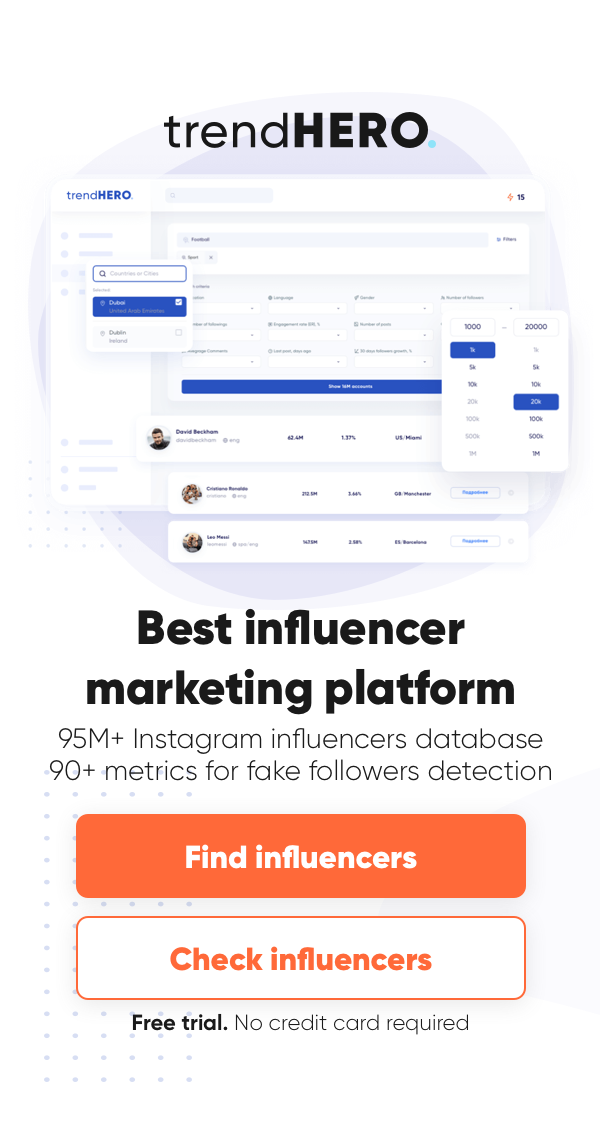- Home
- BLOG
- Instagram Marketing
- Creating a Social Media Marketing Strategy in 8 Easy Steps
Social media is a fantastic marketing tool. But you will only see the benefits if you know how to use it well. And that means developing the perfect marketing strategy to guide your activities.
Many companies are gravitating toward social media. As of 2022, the ad spend on the platforms was approximately $230 billion. Projections for 2024 show that the figure could surpass the $300 billion mark.
With over 4.59 billion users, companies have the opportunity to reach a broad target audience base. But breaking through the clutter requires the right plan.
Creating a strong social media marketing strategy is essential in today’s digital world. Having the right social media presence is essential for any business and can help them gain valuable exposure, build customer relationships, and reach out to new customers.
It all starts with crafting a well thought out social media strategy and tailoring it to the needs of your business. This entails defining your objectives, researching which platforms and tactics could provide the most benefit.
Understanding how they fit into your overall marketing strategy, and setting up a plan to measure success and make improvements is key to an overall effective strategy.
It is a fact that with the right approach, you can leverage the amazing potential of social media to achieve your goals.
Social Media Marketing Strategy: What Is It?
A social media marketing strategy is an outline of goals, tactics, and metrics in a document form.
Please note you may need to create specific plans for each platform you will use. For example, what you do on Facebook may differ from TikTok or Instagram. You must consider factors like the target audience, resources available, and the overall business goals.
As we said, tactics also matter. Let’s say you plan to use performance marketing service providers for your social media marketing. Your goal could be to achieve minimal digital marketing expenditure. And you will accomplish this by only paying for services based on performance or desired results.
Your desired action from the performance marketers would be increased shares, impressions, downloads, or lead captures.
1. Audit Your Social Media Strategies
If you already have a social media presence that is not working, find out why. And you can only get your answers by conducting a social media audit.
Ask yourself questions like:
- Do you have clear goals, and are you meeting them?
- Who are you talking to, and on which platforms?
- What are some things you are doing that are giving you ROI?
- What type of partnerships do you have?
- How do you compare to the competitors?
- Is your content resonating with the target audiences, etc.?
If the answer to most questions shows significant gaps, it is time to return to the drawing table. Remember, it is crucial to consider your strategies as living documents. That means you can change them as much as you need to.
2. Define Your Social Media Marketing Goals
Every digital marketing initiative should yield some results. That requires careful thought about exactly what you want to achieve.
Consider the same when coming up with a social media marketing strategy. Look at the business and decide what areas need the most focus.
Do you want to:
- Increase brand awareness
- Generate leads
- Drive sales or conversions
- Advertise products or services to specific audiences
- Gain market insights from social listening
- Increase website traffic, etc
S.M.A.R.T goals
The SMART technique provides an excellent guide to setting up goals. So look at your goals again and ensure they are:
- Very specific, devoid of ambiguity or grey areas
- Measurable requires that you have key performance indicators (KPIs) or metrics for benchmarking.
- Achievable in that your teams can attain what you set out to do. If you do not have in-house resources, consider digital performance marketing specialists. As we said, you only pay if they give you desired results. And since you only use the performance marketer on a need-to basis, you will realize tons of savings. You don’t have to deal with the attendant cost of n-house staff.
- Realistic in that the goals are within reach and relevant to your business
- Time-bound, which requires the setting of specific timelines within which you hope to achieve the goals.
3. Determine the Target Audience
As we stated, as a brand, social media allows you to reach a broad audience base. But not everyone who is on social media is a target audience. That is why you must, from the onset, identify who you want to talk to. It is a process that entails plenty of research.
Find out factors like:
- What do your target audiences need, which means identifying the pain points?
- What are their personal preferences?
- Which demographics are you talking to regarding age, economic status, educational background, etc.?
- What are their hobbies, interests, likes, and dislikes?
- When are they most active on social media?
- Which platforms do they frequent the most?
- What kind of content do they interact with, etc.?
Identifying your target audience may be one of the most challenging steps. Yet, you must get it right to succeed in your social media marketing.
4. Find out What Your Competitors Are Doing
It is industry practice to know what your competitors are doing. Carrying out competitor analysis helps with:
- You get a chance to see what is working, or not, for them
- It will help with developing your strategy because you can improve on what they’re doing. Or you can come up with different techniques that will work.
- Identify gaps that you can maximize to achieve good results
- See what people are saying about the competitors to know what to avoid or employ
- Identify trends that can boost your social media marketing strategy
5. Decide On the Social Media Platforms You Will Use
There are specific considerations when choosing social media marketing platforms.
- Is your target audience on the platform you choose? For example, promoting your products on LinkedIn will only work for professionals. If you hope to target the younger demographics, Instagram and TikTok are where you should be.
- Your objectives also have a significant role to play. Platforms like Facebook and LinkedIn are fantastic examples for building brand awareness. You have more leeway with the type of content you can use. Instagram will work great for influencer marketing or picture-heavy content, etc. Use the fake follower check to determine the influencer’s audience authenticity score.
- What tactics do you want to use? YouTube, Instagram live, and Facebook are great for live streaming. Facebook and Instagram are great for user-generated content (UGC), etc.
- Does your platform have all the relevant features and capabilities you need for your campaigns?
- Which platforms are your competitors using, and do you want to join the clutter?
- Ensure the platform has analytics and reporting capabilities.
When choosing a platform, select the one that will give you the best results. There is no point in spreading all over because it will be hard to manage them all.
6. Develop Techniques for Each Platform
Once you decide on the platform, develop specific tactics for each.
- Instagram stories and Snapchat are fantastic for tutorials
- Twitter is excellent for customer service
- LinkedIn gives direct access to Professionals and will work for B2B marketing.
Now set up your profiles, ensuring you fill in the necessary fields. Also, apply consistency with branding, and use the right keywords. You want audiences to find you with words or phrases they use most.
7. Think About Your Content Strategy
Creating engaging and relevant content will help attract more followers, generate more leads and nurture relationships. Your content should be tailored to your target audience and should also be aligned with your brand’s messaging and objectives.
Consider what type of content resonates with your audience, what problems it can solve, and if it creates an emotional response.
Also, remember the social nature of the platforms. Avoid hard-sell marketing language. Instead, use engaging, entertaining, and informative content.
It is of utmost importance that you schedule your posting. You want consistency while being realistic about how much you can handle.
Once again, go back to your understanding of the target audiences. When are they most likely to use social media platforms? Younger people may be online the whole day. But for older demographics, that may not be the case. Work and life demands may mean that they only check social media when having a coffee break or during weekends.
Also, avoid using the same type of content. Mix it up with posts, pictures, and videos. Others are shareable assets like Infographics, ePapers, and research findings. Remember, the more the audiences engage with the content, the higher the chances of shares, likes, and comments.
Another good idea is to partner with influencers. You can tap into their existing audience base. A simple tip is to choose one that aligns with your brand. And beyond a sizable following, make sure they attract relevant engagement.
8. Keep Up With Tracking Performance
We talked about the importance of setting KPIs from the very beginning. We also highlighted analytics as an essential feature.
Tracking performance allows you to change what is not working. Keep up with the evaluation and keep on testing until you get what works well for your brand.
Final Thoughts
What you will realize with developing a social media strategy is that you never quite finish the job. Measuring performance requires that you keep on tweaking. There are also constant market shifts that you must adjust to.
Developing an excellent social media marketing strategy is a complex task. A fantastic alternative is to outsource the work to performance marketers. You agree beforehand on the desired results and only pay if you see them.
FAQ
What does social media marketing entail?
Social media marketing is promoting brand products or services on social platforms. These include Facebook, LinkedIn, Instagram, Twitter, and YouTube.
What is the main strength of social media marketing?
There are several, including:
- Access to a broad audience base
- Many tactics to reach audiences. These include blog posts, live streaming, videos, user-generated content, etc.
- Analytics to measure performance
What is the best way to know if my social media marketing efforts are working?
You must keep up with measuring performance, using the analytics on the platforms. You will also see changes in engagement rates, website traffic, higher conversions, etc.
What is performance marketing?
This is a type of pay-for-results-only type of service. You agree beforehand, or the service providers should achieve and only pay if they do.
We also recommend to read
Instagram Engagement Rate Calculator For Free
Check any influencer's Engagement rate and analyze his or her followers growth history
Other free tools: Follower Count History, Instagram Follower Count, CPM Calculator





